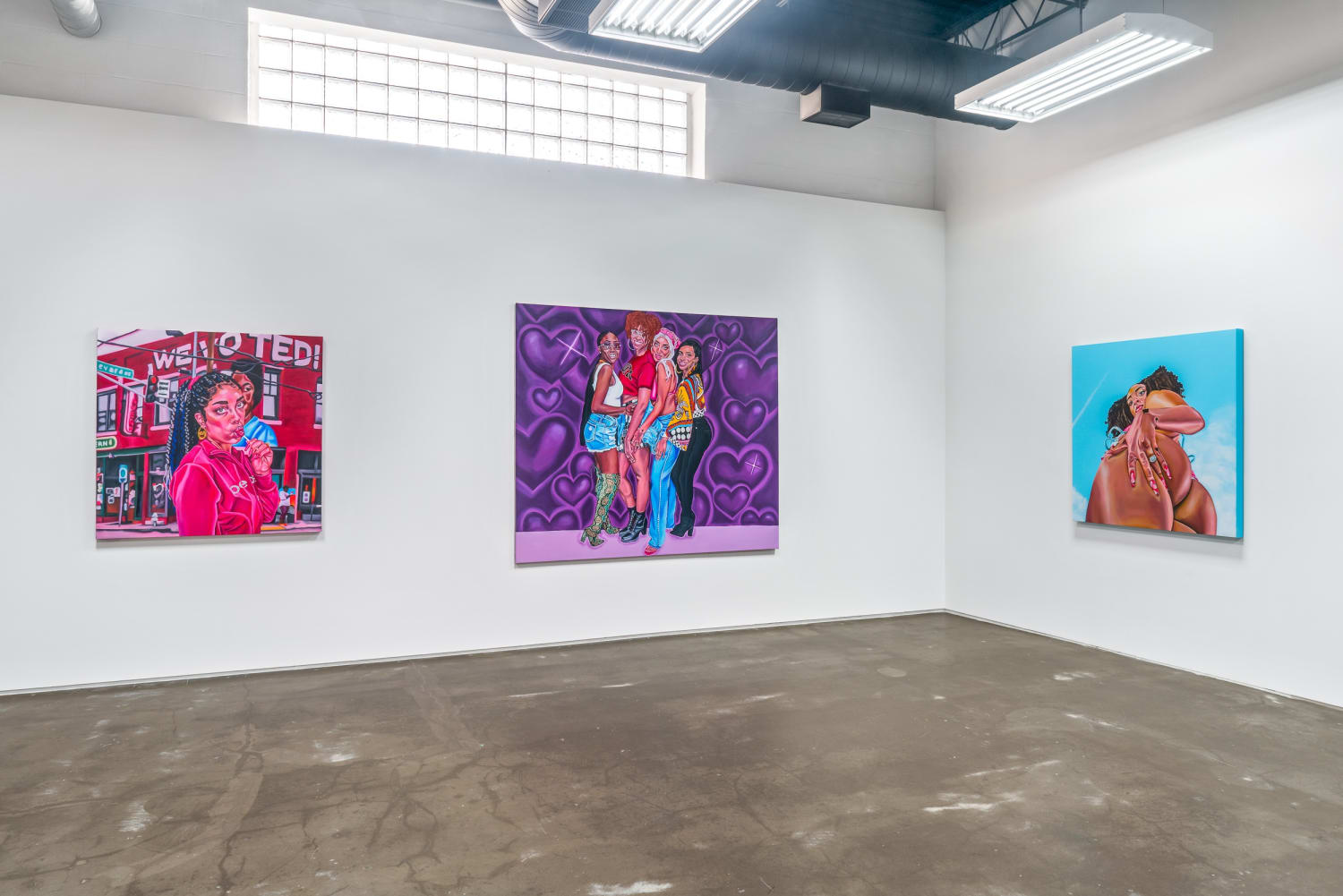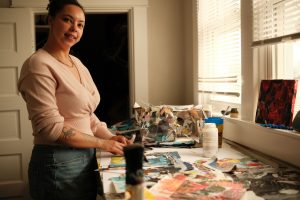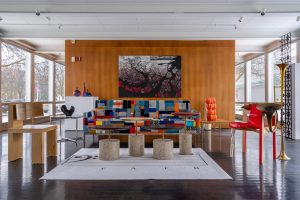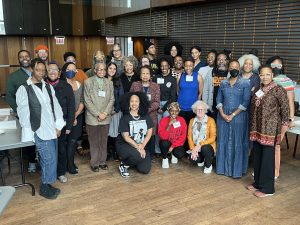Featured image: An installation view of We Outside. Image Courtesy of the artist and Monique Meloche Gallery, Chicago.
“[Hot Girl Summer is] just basically about women—and men—just being unapologetically them, just having a [good] time, hyping up your friends, doing you, not giving a damn about what nobody got to say about it.”
Megan Thee Stallion
In 2019 Megan Thee Stallion iconically gave us the term Hot Girl Summer. A year later the saying would become more than a song lyric and trending topic but a whole mood emblematic of the world we desperately wanted post-pandemic. Painter Ariel Dannielle uses the beauty in Black femininity to memorialize the explosion of joy that came the summer after lockdown. The show We Outside at Monique Meloche Gallery is an ode to Black women, the ones who start the trends with their multicolored hair, laid edges, and stiletto nails, the modern party girl, and survivor of a pandemic. In her five canvases, she vibrantly depicts those Black women in all shapes and shades unencumbered and unabashedly happy.
I loved every inch of the exhibition. So much so that I had to get in touch with the artist. A few days before Thanksgiving Ariel and I had an easy conversation about working in art, working with friends, sexuality as self-love, and the simple joy of Blackness.
Jen Torwudzo-Stroh: Tell me about yourself and your art in your own words
Ariel Dannielle: I was born and raised in Georgia, and I currently live in Atlanta. I paint from my life and my experiences. My goal with my work is to show the fun parts of being Black. A lot of the time the fun parts are not what people think of when we’re represented. I just want to show what it’s like to have fun, to be Black and to love it, to be with your friends. I want to show my experiences in a positive light. I want my work to leave people feeling joy.
JTS: What drew you to self-portraiture?
AD: When I was in college trying to figure out what kind of art I was into; I didn’t know. I had tested out every kind of art class to figure out what stuck with me. I started practicing and doing self-portraits because it was easier. I would just take selfies and practice like that. And that evolved into me using myself to tell the stories I wanted to tell. I realized that I can be my own story. When I first started doing them I was just playing around. I didn’t know it was going to resonate with people. But my friends would be like, “that’s so me!” and I realized that it doesn’t matter that it’s a self-portrait, you can still see yourself in that figure even if it’s my face. So I just keep it going. It kinda became my style to always include myself in my work.
JTS: Can you tell us about your creative process and what that work looks like?
AD: I get random ideas just throughout my day-to-day life. I get inspiration through photos, Instagram, Tumblr, or from being out in the world with my friends and partner. I usually stage the image first. I can see the painting in my mind and I have mini photoshoots at my house. With, “We Outside”, I had one full day. My friends came over and we took a bunch of different photos to match the ideas I pictured in my mind. It’s a lot of fun. They know the whole point of my work and they want to be there to help create the picture with me. It‘s always fun vibes. I use my friends for pretty much every show I’ve done. They already know, when I’m like, ‘Alright ladies, come over let’s take some photos!’ I really like the photoshoot process, because I also do it with not just my friends but for myself with solo paintings. Once I get the shot, I project it on the canvas, outline it and paint it.
JTS: These are pictures of you and your friends, how do you part with such personal work?
AD: It’s not easy, it’s not easy! I honestly struggle, it’s emotional. I’m not a particularly fast painter so I put so much time and emotion into my work because it’s based off my life. It’s very personal and time-consuming and then like it’s done and it’s gone. The show at Monique’s gallery, I got to the opening so late by accident and I was only there for like an hour, and then it was over. I could’ve cried. I only got one hour with them and then I had to fly back to Georgia. It freaked me out. I mean it was my fault for being so late, I was trying to be fashionably late, but long story short I struggle when—there’s a part of me that be like, I want them a little longer. But then I be like, girl you got bills. All I can really do is look at them [the pictures of the paintings] on my phone. But pictures don’t really do them justice.
JTS: On social media, the saying “We outside!” became a post-covid proclamation of survival, what does that mean to you specifically in this exhibition?
AD: I felt like after last year I wanted to showcase us, me and my friends, being outside. I wanted it to be a fun representation of that. After we all got vaccinated, being able to see each other and do things helped our mental health. We have been trying to do little things here and there to help us feel good after last year. We’re just trying to make the best out of it. I want my next show to be a continuation of the theme. This show at the gallery was just an intro, it was 5 pieces. If the next show I do can be bigger it would be 10 pieces around this topic. I want to have one big show like that. Where all my friends can come out. I have a whole vision for a show hopefully in the future.
JTS: In your artist statement, you mention that you were influenced by Megan Thee Stallion’s Hot Girl Summer. What was it about the term that resonated with you?
AD: I just like that it took off. She said it and then it was everywhere. Everyone was talking about hot girl summer. I just thought it was such an iconic moment for her to have coined the term and we all just took it and ran with it. It’s such a simple thing it is just like being out and having a good time with your friends and that’s what me and my friends are all about. It’s the same thing as We Outside, everyone’s saying it and resonated with us so I just thought it was cool.
JTS: Why is that important to you to show Black women as sexual and confident figures?
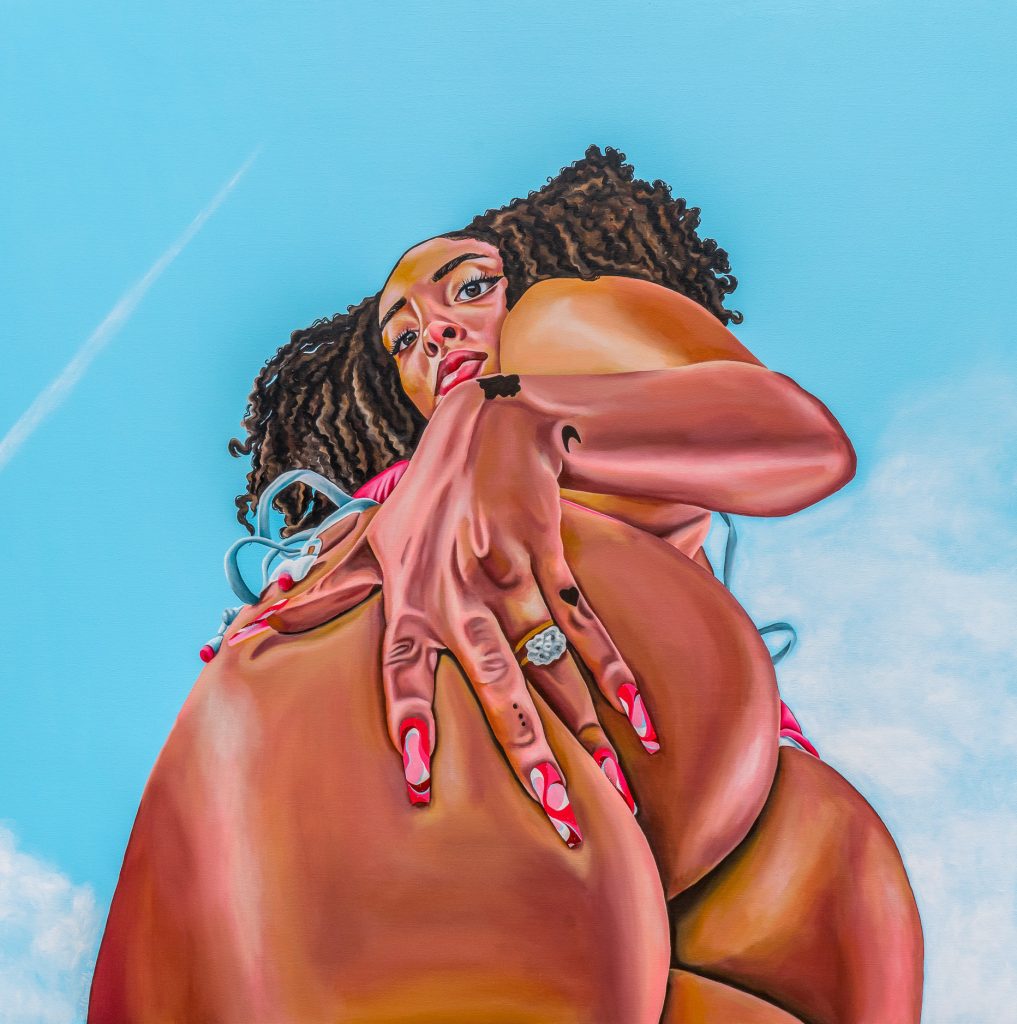
AD: I think but it’s funny because I don’t even think it’s sexy. I don’t think I’m a particularly sexy person, I think I’m silly. I do want to depict all of the people in my paintings very confidently. I just like the idea of having a Black woman stare you dead in your eye in these paintings. It goes with my whole mission of depicting Black women in my joyous scenarios feeling confident and cute.
Catch Those Angles is one of the sexiest paintings I’ve done. It played on the hot girl summer thing but also I went to Cancun for my birthday this year because I turned 30. I wanted to take some sexy photos and I was gonna do my angles. It was literally just for myself.
JTS: How do you approach painting Black skin?
AD: I’m all about the colors. I don’t think I have a great eye for color, but I be acting like I know people’s undertones. I look at my friend and be like, “you have a purple undertone, you have an orange undertone, you have a pink undertone,” I feel like I know everyone’s undertones. I always want that to be shown in my paintings because personally I just like colorful paintings. I want them to be colorful, bright, and fun. We come in all different shades so I try to make sure that there’s a variety with each person. We’re all different.
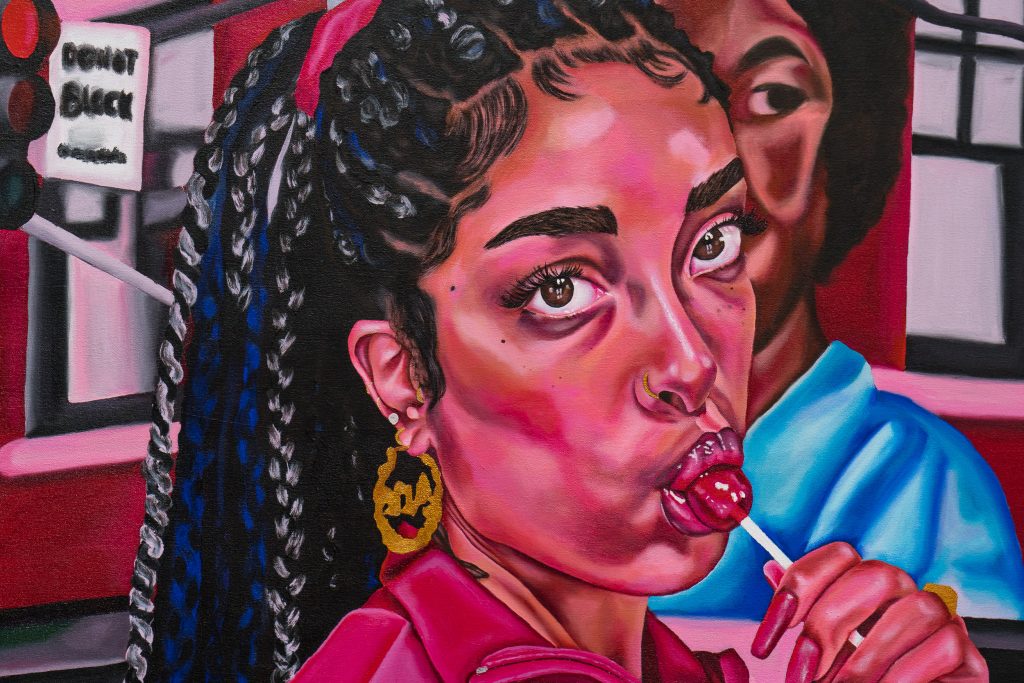
Weekends on Edgewood is so pink because at certain times of the year I have a pink undertone and also like for a large part of this year I just had an obsession with the color pink. I was buying pink everything: clothes, bags, makeup. That painting was in my pink era this year. Sometimes I just get obsessed with a certain color for a couple of months and I incorporate it into my paintings.
JTS: What is something that is misunderstood about Black women and that you’re trying to articulate in your show?
AD: I choose Black women because I am a Black woman and it’s the only perspective I can personally give. But I just think as Black people we’re just defined in a lot of ways by our trauma. There are all these stigmas. Black women are angry, we’re victims, we’re this or that. A lot comes with being a Black woman. Because of that, I want to show the other side of it. We’re fun, we’re cute, we’re confident we’re literally normal people that aren’t just defined by our trauma. Like it’s not easy but also like you know I’m still out here trying to make the best out of life. I just want that to be seen. There’s a space for everything, if you want to see a painting about struggling and the hard parts of being a person of color there are artists that are going to tell that story. It’s powerful, but I feel like joy can be powerful too.
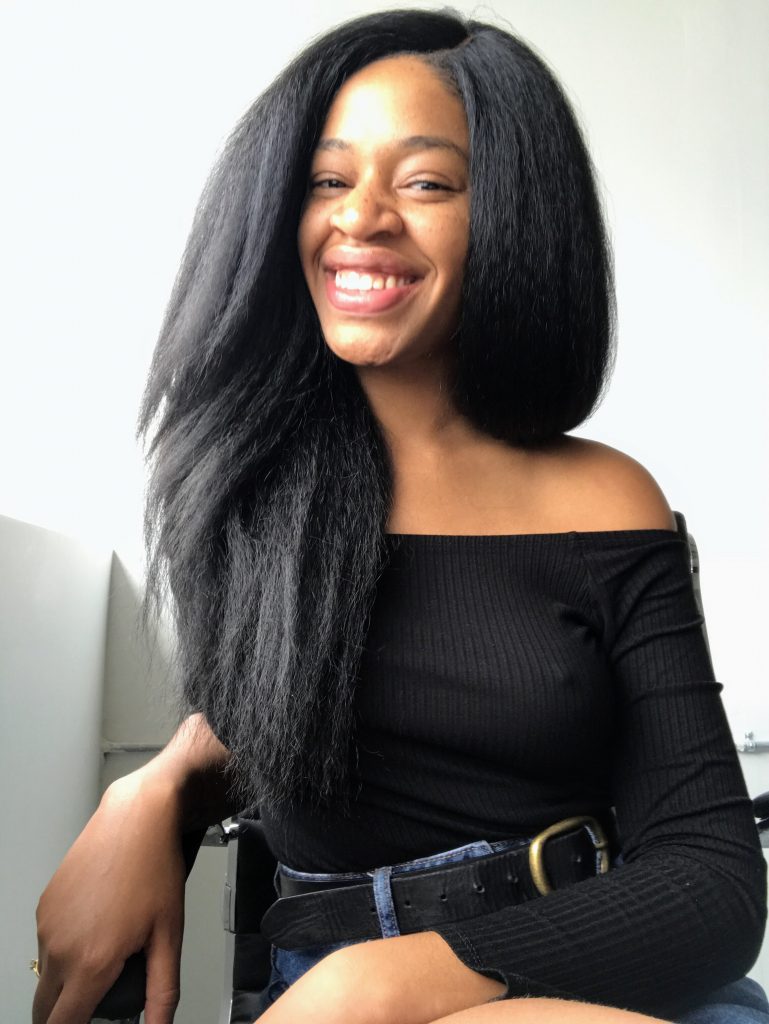
Jen Torwudzo-Stroh is an arts and culture professional and freelance writer based in Chicago, IL.
